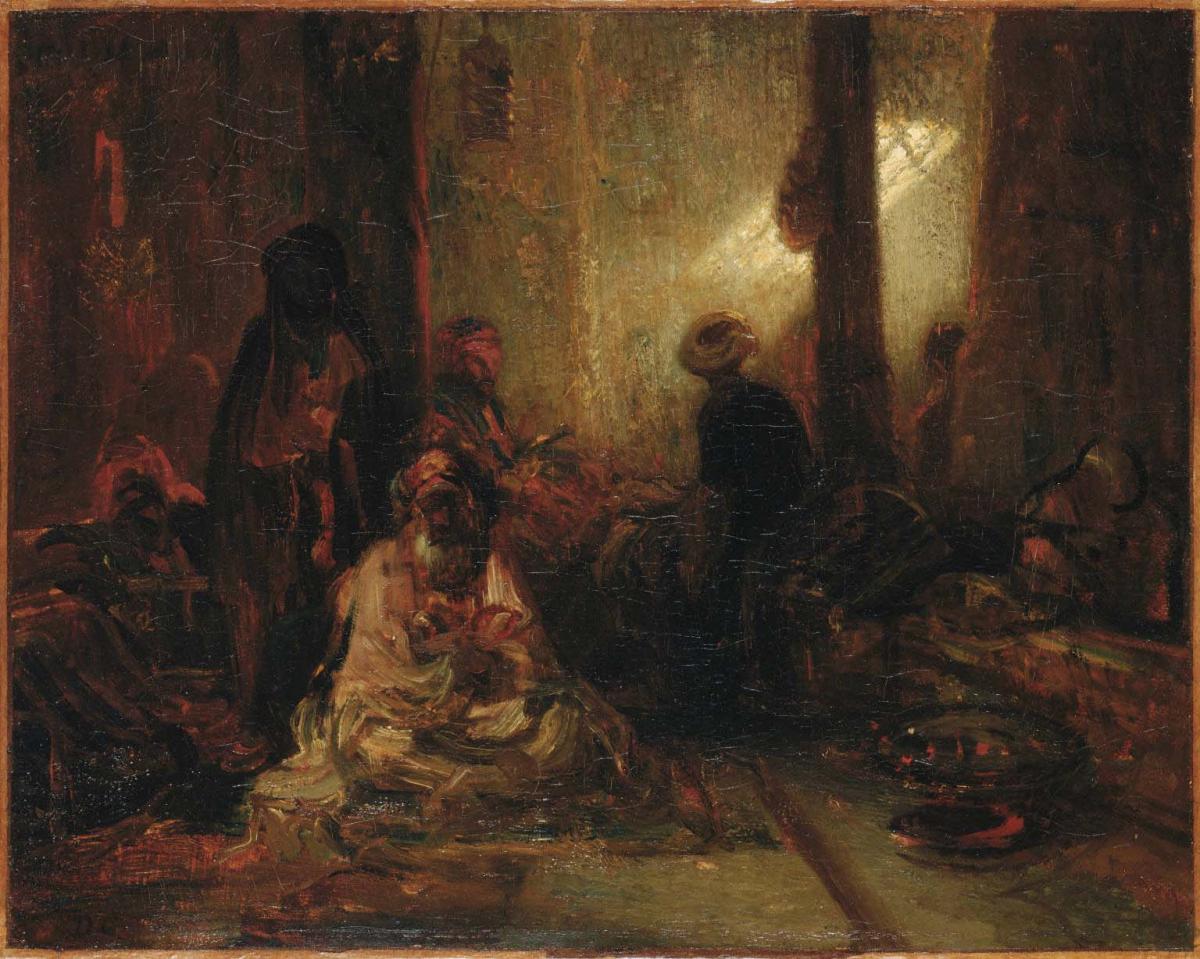Interior of a Turkish Cafe
Alexandre-Gabriel Decamps ( 1833 or later )

Interior of a Turkish Café reflects the romantic interest in oriental subjects that prevailed during the first half of the nineteenth century and that would also engage artists like Delacroix and Ingres as well as literary figures. Decamps’s attachment to Near Eastern themes was evident from the outset of his career; his Arabes devant une Maison, 1823 (Saint-Etienne, Museum), for example, predated his visit to the Orient. When Decamps embarked for the Near East in 1828, he became one of the first European artists to see the region firsthand. Unlike the artists who journeyed there in mid-century in pursuit of documentary realism, Decamps eschewed detailed drawings after nature; rather, according to the contemporary critic Paul Mantz, he absorbed impressions “with his glance rather than with the pencil.” Such observations constituted a rich source of inspiration that he was to harvest for the remainder of his career.
Interior of a Turkish Café was painted after his return to France. A genre scene, it shows a group of standing and seated figures in robes and turbans, assembled before a recess and bathed in liquid semidarkness. The composition is unified by Decamps’s heavily worked technique, a characteristic of his style that distinguished it from the polished surfaces of contemporaneous Salon painting.
For many artists who traveled to the Near East, the brilliant and scorching sun was the primary challenge. Eugène Fromentin, a fellow artist and writer who spent time there, felt it necessary to explain Decamps’s penchant for Rembrandtesque interiors: “Not able directly to capture the sun, which burns the hands that attempt it, he took a more ingenious detour, and, given the impossibility of suggesting a lot of sunlight with few shadows, he thought that with a lot of shadows he might succeed in producing a bit of sunlight.” Indeed, the cavelike dimness of Interior of a Turkish Café gives dramatic relief to the shaft of light that enters the room from the right and that is made even more palpable though the use of impasto. At the same time, however, Decamps exploited the shadows in order to create a mood of quiet contemplation and exotic indolence. Fromentin himself had succumbed to the limpid, colored shadows of the lands of the sun, and another entry from his journal could almost be read as a gloss on the present painting: “…figures float in some kind of blond atmosphere that makes contours disappear.” They are rendered immobile, like statues, and “…only now and then does a misplaced fold, a gesture, recall life.”
Duncan Phillips purchased this work jointly with his brother from the Ichabod T. Williams Collection, which Phillips, then at the beginning of his collecting career, dubbed “one of the most distinguished collections I have seen.” Shortly before, Phillips had included Decamps in an essay entitled “Impressionism in Prose.” In keeping with his early predilection for romantic, literary themes, much of the text is devoted to writers, but Phillips, in a brief digression, invoked Decamps: “It was the taste for sumptuous backgrounds that sent the painters Delacroix, Decamps, and Fromentin to the Orient. To my mind it is only Decamps who had the Orient in his own soul and was able therefore to bring it back with him on canvas.”
Later, Phillips endeavored to characterize the distinctive quality of Decamps’s technique in more pictorial terms, claiming “he was not literary in his romanticism. He was purely and perhaps superficially a sensuous painter.” According to Phillips, Decamps laid the “foundations not only for all future romantics who were to use color, as musicians use sounds, for their own sake…but also for all the great painters of our day who have devoted their lives to the study of effects of light.”